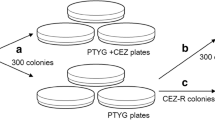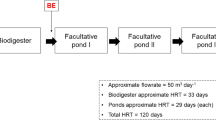Abstract
This study investigates levels of bacteria through population indicators as well as the levels of antibiotic-resistance bacteria in dairy manure. Although overall bacteria levels may be reduced during manure processing, it is of interest whether changes in management practices could lead to increased levels of antibiotic-resistance bacteria, which are becoming more prevalent in agricultural soils, groundwater, and surface water. Appropriate manure treatments are needed not only to reduce the potential risk of exporting antibiotic-resistant bacteria to an environment, but also reduce antibiotic-resistant bacteria exposure to animals if processed water is recycled. Results from this research revealed manure separation under relatively low speed centrifuge with 100 ppm polyacrylamide (PAM) emulsion addition reduced bacteria indicators population such as total coliforms and Escherichia coli (E. coli) significantly in the liquid stream compared to no PAM added. However, the percentages of antibiotic-resistant isolates in liquid stream after centrifuge with PAM were higher compared to raw manure and no PAM added. Antibiotic resistance (cephalosporin, florfenicol, penicillin, or tetracycline) was observed or 65.38% of bacterial isolates in manure from a large dairy farm in Wisconsin and 39.29% of isolates demonstrated multidrug resistance. The results from this study strongly suggest that appropriate manure treatment is essential in order to help minimize the abundance of antibiotic resistance in our water environment.


Similar content being viewed by others
References
Kenny, J., Barber, N., Hutson, S., Linsey, K., Lovelace, J., & Maupin, M. (2009). Estimated use of water in the United States in 2005. Virginia: U.S. Geological Survey.
Morris, B. L., Lawrence, A. R. L., Chilton, P. J. C., Adams, B., Calow, R. C., & Klinck, B. A. (2003). Groundwater and its susceptibility to degradation: a global assessment of the problem and options for management. Keyworth: British Geological Survey.
Angenent, L. T., Mau, M., George, U., Zahn, J. A., & Raskin, L. (2008). Effect of the presence of the antimicrobial tylosin in swine waste on anaerobic treatment. Water Research, 42, 2377–2384.
Kemper, N., Färber, H., Skutlarek, D., & Krieter, J. (2008). Analysis of antibiotic residues in liquid manure and leachate of dairy farms in northern Germany. Agricultural Water Management, 95, 1288–1292.
Massé, I. D., Cata-Saady, N. M., & Gilbert, Y. (2014). Potential of biological processes to eliminate antibiotics in livestock manure: an overview. Animals, 4, 146–163.
Sarmah, A. K., Meyer, M. T., & Boxall, A. B. A. (2006). A global perspective on the use, sales, exposure pathways, occurrence, fate and effects of veterinary antibiotics (VAs) in the environment. Chemosphere, 65(5), 725–759.
Shea, K. M. (2003). Antibiotic resistance: what is the impact of agricultural uses of antibiotics on children’s health? Pediatrics, 112, 253–258.
Arikan, O. A., Mulbry, W., & Rice, C. (2009). Management of antibiotic residues from agricultural sources: use of composting to reduce chlortetracycline residues in beef manure from treated animals. Journal of Hazardous Materials, 164, 483–489.
National Research Council. (1999). The use of drugs in food animals: benefits and risks. Washington DC: National Academy Press.
Mellon, M., Benbrook, C., & Benbrook, K. (2001). Hogging it!: estimates of antimicrobial abuse in livestock. Cambridge, MA: Union of Concerned Scientists.
Bound, J. P., & Voulvoulis, N. (2004). Pharmaceuticals in the aquatic environment-a comparison of risk assessment strategies. Chemosphere, 56, 1143–1155.
Kumar, K., Gupta, S. C., Chander, Y., & Singh, A. K. (2005). Antibiotic use in agriculture and its impact on the terrestrial environment. Advances in Agronomy, 87, 1–54.
Pathak, S. H. C. (2010). Antibiotics in manure and soil-a grave threat to human and animal health. New Delhi: National Academy of Agriculture Science.
Mackie, R. I., Koike, S., Krapac, I., Chee-Sanford, J., Maxwell, S., & Aminov, R. I. (2006). Tetracycline residues and tetracycline resistance genes in groundwater impacted by swine production facilities. Animal Biotechnology, 17, 157–176.
Martinez, J. L. (2009). Environmental pollution by antibiotics and by antibiotic resistance determinants. Environmental Pollution, 157, 2893–2902.
Esiobu, N., Armenta, L., & Ike, J. (2002). Antibiotic resistance in soil and water environments. International Journal of Environmental Research, 12(2), 133–144.
Liu, Z., Sharara, M., Gunasekaran, S., & Runge, T. (2016b). Effects of large-scale manure treatment processes on pathogen reduction, protein distributions, and nutrient concentrations. Transactions of the ASABE, 59(2), 695–702.
Vanotti, M., Rashash, D., & Hunt, P. (2002). Solid-liquid separation of flushed swine manure with PAM: Effect of wastewater strength. Transactions of the ASAE, 45, 1959–1970.
Amuda, O., & Alade, A. (2006). Coagulation/flocculation process in the treatment of abattoir wastewater. Desalination, 196, 22–31.
Liu, Z., Carroll, Z. S., Long, S. C., Roa-Espinosa, A., & Runge, T. (2017). Centrifuge separation effect on bacterial indicator reduction in dairy manure. Journal of Environmental Management, 191, 268–274.
Liu, Z., Carroll, Z. S., Long, S. C., Gunasekaran, S., & Runge, T. (2016a). Use of cationic polymers to reduce pathogen levels during dairy manure separation. Journal of Environmental Management, 166, 260–266.
Zhang, R., & Westerman, P. (1997). Solid-liquid separation of animal manure for odor control and nutrient management. Applied Engineering in Agriculture, 13, 385–393.
American Public Health Association (APHA). (2005). Standard methods for the examination of water and wastewater. Washington DC: American Water Works Association, Water Environment Federation.
Garzio-Hadzick, A., Shelton, D., Hill, R., Pachepsky, Y., Guber, A., & Rowland, R. (2010). Survival of manure-borne E. coli in streambed sediment: effects of temperature and sediment properties. Water Research, 44(9), 2753–2762.
Wong, S., Teng, T., Ahmad, A., Zuhairi, A., & Najafpour, G. (2006). Treatment of pulp and paper mill wastewater by polyacrylamide (PAM) in polymer induced flocculation. Journal of Hazardous Materials, 135, 378–388.
Choi, K. J., Kim, S. G., & Kim, S. H. (2008). Removal of antibiotics by coagulation and granular activated carbon filtration. Journal of Hazardous Materials, 151, 38–43.
Qiang, Z. H., & Adams, C. (2004). Potentiometric determination of acid dissociation constants (pKa) for human and veterinary antibiotics. Water Research, 38, 2874–2890.
Keyes, K., Hudson, C., Maurer, J. J., Thayer, S., White, D. G., & Lee, M. D. (2000). Detection of florfenicol resistance genes in Escherichia coli isolated from sick chickens. Antimicrobial Agents and Chemotherapy, 44(2), 421–424.
Bolton, L. F., Kelly, L. C., Lee, M. D., Fedorka-Cray, P. J., & Maurer, J. J. (1999). Detection of multidrug-resistant salmonella enterica serotype typhimurium DT104 based on a gene which confers cross-resistance to florfenicol and chloramphenicol. Journal of Clinical Microbiology, 37, 1348–1351.
Kim, E. H., & Aoki, T. (1996). Sequence analysis of the florfenicol resistance gene encoded in the transferable R-plasmid of a fish pathogen, Pasteurella piscisida. Microbiology and Immunology, 40, 665–669.
Kümmerer, K. (2009). Antibiotics in the aquatic environment – a review – Part II. Chemosphere, 75, 435–441.
Bouki, C., Venieri, D., & Diamadopoulos, E. (2013). Detection and fate of antibiotic resistant bacteria in wastewater treatment plants: a review. Ecotoxicology and Environmental Safety, 91, 1–9.
Diaz-Cruz, M. S., Lopez de Alda, M. J., & Barcelo, D. (2003). Environmental behavior and analysis of veterinary and human drugs in soils, sediments and sludge. TrAC Trends in Analytical Chemistry, 22, 340–351.
Batt, A. L., Snow, D. D., & Aga, D. S. (2006). Occurrence of sulfonamide antimicrobials in private water wells in Washington County, Idaho, USA. Chemosphere, 64, 1963–1971.
Giger, W., Alder, W. A. C., Golet, E. M., Kohler, H. P. E., McArdell, C. S., Molner, E., Siegrist, H., & Suter, M. J. F. (2003). Occurrence and fate of antibiotics as trace contaminants in wastewater, sewage sludges, and surface waters. Chimia International Journal for Chemistry, 57, 485–491.
Salyers, A. A., Gupta, A., & Wang, Y. (2004). Human intestinal bacteria as reservoirs for antibiotic resistance genes. Trends in Microbiology, 12, 412–416.
Chee-Sanford, J. C., Mackie, R. I., Koike, S., Krapac, I. G., Lin, Y. F., Yannarell, A. C., Maxwell, S., & Aminov, R. I. (2009). Fate and transport of antibiotic residues and antibiotic resistance genes following land application of manure waste. Journal of Environmental Quality, 38, 1086–1108.
Boxall, A. B. A., Fogg, L. A., Blackwell, P. A., Kay, P., Pemberton, E. J., & Croxford, A. (2004). Veterinary medicines in the environment. Reviews of Environmental Contamination and Toxicology, 180, 1–91.
Helland, T., Bergheim, M., Längin, A., Kallenborn, R., & Kümmerer, K. (2010). Temperature dependent degradation of benzylpenicillin (penicillin-G) under controlled laboratory conditions. Chemosphere, 81, 1477–1485.
Längin, A., Alexy, R., König, A., & Kümmerer, K. (2009). Deactivation and transformation products in biodegradability testing of ß-lactams amoxicillin and piperacillin. Chemosphere, 75(3), 347–354.
Gavalchin, J., & Katz, S. E. (1994). The persistence of fecal-borne antibiotics in soil. Journal of AOAC International, 77, 481–485.
Alekshun, M. N., & Levy, S. B. (1999). The mar regulon: multiple resistance to antibiotics and other toxic chemicals. Trends in Microbiology, 7, 410–413.
Khanna, T., Friendship, R., Dewey, C., & Weese, J. S. (2008). Methicillin resistant Staphylococcus aureus colonization in pigs and pig farmers. Veterinary Microbiology, 128, 298–303.
Smith, T. C., Gebreyes, W. A., Abley, M. J., Harper, A. L., Forshey, B. M., Male, M. J., Martin, H. W., et al. (2013). Mechicillin-resistant Staphtlococcus aureus in pigs and farm workers on conventional and antibiotic-free swine farms in the USA. PLoS One, 8(5), 63704.
Singer, A. C., Shaw, H., Rhodes, V., & Hart, A. (2016). Review of antimicrobial resistance in the environment and its relevance to environmental regulators. Frontiers in Microbiology, 7, 1728.
Funding
This work was supported by the United States Department of Agriculture-National Institute of Food and Agriculture (USDA BRDI Grant Number 2012-10006-19423). This was also supported by Texas A&M Agrilife and administered by the Department of Bio and Agricultural engineering at Texas A&M University.
Author information
Authors and Affiliations
Corresponding author
Additional information
Publisher’s Note
Springer Nature remains neutral with regard to jurisdictional claims in published maps and institutional affiliations.
Rights and permissions
About this article
Cite this article
Han, S., Long, S.C., Runge, T. et al. Impact of Dairy Manure Processing Using Polyacrylamide on Antibiotic-Resistant Bacterial Level. Water Air Soil Pollut 230, 58 (2019). https://doi.org/10.1007/s11270-019-4110-4
Received:
Accepted:
Published:
DOI: https://doi.org/10.1007/s11270-019-4110-4




